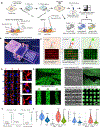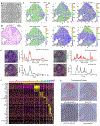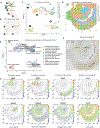High-Spatial-Resolution Multi-Omics Sequencing via Deterministic Barcoding in Tissue
- PMID: 33188776
- PMCID: PMC7736559
- DOI: 10.1016/j.cell.2020.10.026
High-Spatial-Resolution Multi-Omics Sequencing via Deterministic Barcoding in Tissue
Abstract
We present deterministic barcoding in tissue for spatial omics sequencing (DBiT-seq) for co-mapping of mRNAs and proteins in a formaldehyde-fixed tissue slide via next-generation sequencing (NGS). Parallel microfluidic channels were used to deliver DNA barcodes to the surface of a tissue slide, and crossflow of two sets of barcodes, A1-50 and B1-50, followed by ligation in situ, yielded a 2D mosaic of tissue pixels, each containing a unique full barcode AB. Application to mouse embryos revealed major tissue types in early organogenesis as well as fine features like microvasculature in a brain and pigmented epithelium in an eye field. Gene expression profiles in 10-μm pixels conformed into the clusters of single-cell transcriptomes, allowing for rapid identification of cell types and spatial distributions. DBiT-seq can be adopted by researchers with no experience in microfluidics and may find applications in a range of fields including developmental biology, cancer biology, neuroscience, and clinical pathology.
Keywords: high spatial resolution; in situ barcoding; mouse embryo; next-generation sequencing; spatial multi-omics.
Copyright © 2020 Elsevier Inc. All rights reserved.
Conflict of interest statement
Declaration of Interests R.F., Y.L., and Y.D. are inventors of a patent application related to this work. R.F. is a co-founder of IsoPlexis, Singleron Biotechnologies, and AtlasXomics and a member of their scientific advisory boards with financial interests, which could affect or have the perception of affecting the author’s objectivity. The interests of R.F. were reviewed and managed by Yale University Provost’s Office in accordance with the University’s conflict of interest policies.
Figures







Comment in
-
Multiomics sequencing goes spatial.Nat Methods. 2021 Jan;18(1):31. doi: 10.1038/s41592-020-01043-w. Nat Methods. 2021. PMID: 33408400
References
-
- Burgess DJ (2019). Spatial transcriptomics coming of age. Nat Rev Genet 20, 317. - PubMed
Publication types
MeSH terms
Substances
Grants and funding
LinkOut - more resources
Full Text Sources
Other Literature Sources
Molecular Biology Databases

